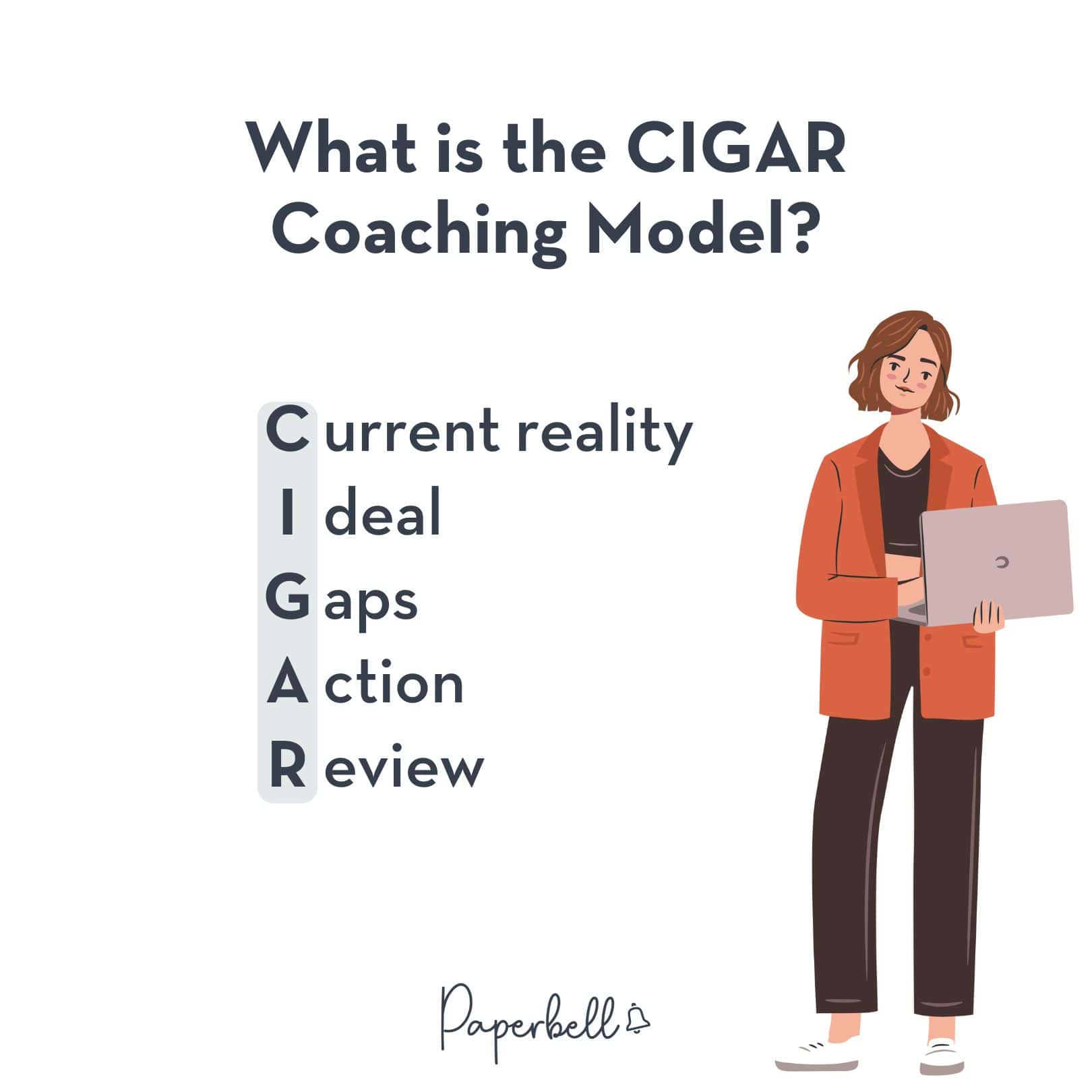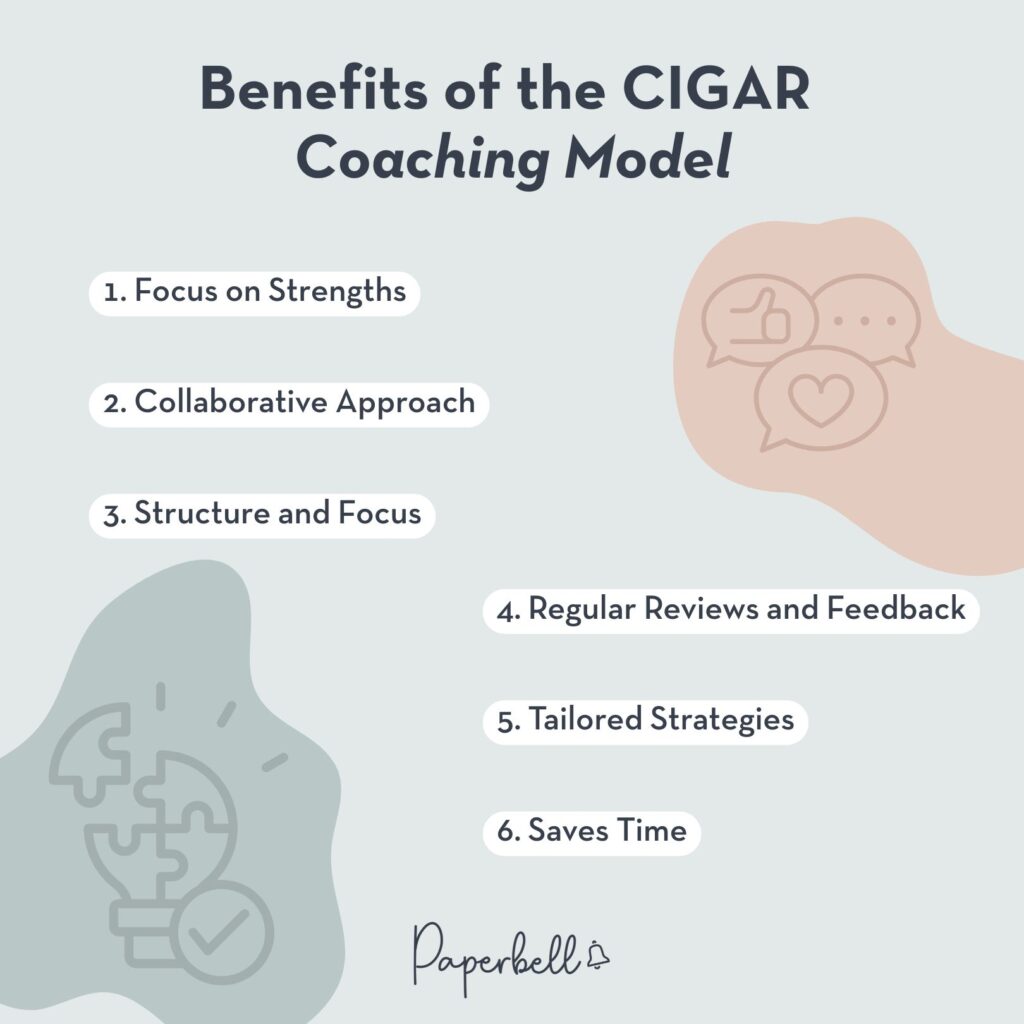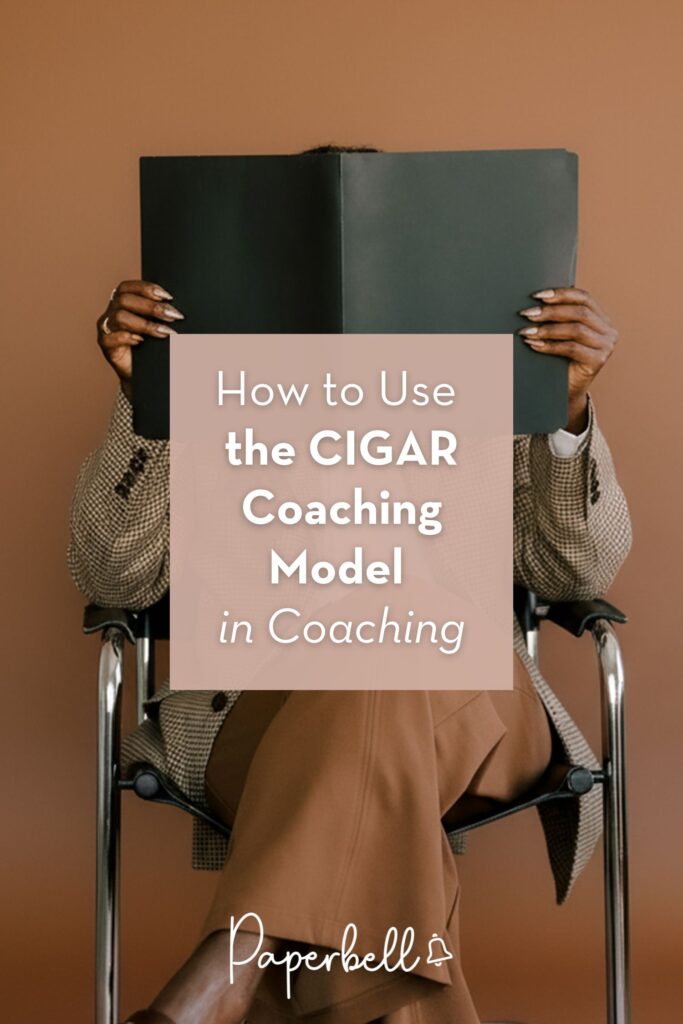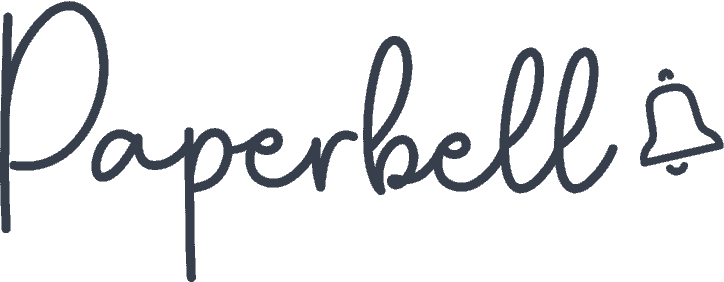Looking for a simple framework to structure your coaching sessions? The CIGAR model gives you a step-by-step way to guide conversations, keep clients focused, and move them toward real progress.
In this article, we’ll cover:
- What the CIGAR coaching model is
- The benefits of using it with clients
- When to apply it in your sessions
What is the CIGAR Coaching Model?

The CIGAR coaching model is a framework that helps clients take ownership of their growth by working step by step from where they are now to where they want to be. It’s used in business, education, and personal development, and it’s valued for its simplicity and clarity.
Created by Suzy Green and Anthony Grant in 2003, this coaching model follows five stages:
- Current reality
- Ideal
- Gaps
- Action
- Review
Here’s how it works in practice:
- You start by exploring your client’s current situation.
- You define the desired outcome they want to achieve.
- You identify the gaps between those two states, such as the skills, habits, or obstacles that stand in the way.
- You design an action plan to close the gaps.
- You follow it up with regular reviews to track the client’s progress.
Imagine an executive client who wants to move into a C-suite role. They might already be a strong leader but lack key skills such as:
- Deeper subject matter expertise in their industry
- The ability to delegate effectively
- Strategic foresight
As their coach, your role would be to help them recognize those gaps, create a plan to develop the missing skills, and keep them accountable as they progress.
By breaking down big goals into these five clear steps, the CIGAR model makes it easier for clients to see where they are, what’s missing, and how to move forward.
Other popular coaching models include:
- The GROW coaching model
- The CLEAR coaching model
- The ACHIEVE coaching model
- The OSCAR coaching model
- The FUEL coaching model
You can learn more about them in our detailed guide.
Pro tip: Coaching models give you structure. Paperbell gives you a whole system. Use it to schedule sessions, manage contracts, and get paid on a single platform.
How to Use the CIGAR Coaching Model Effectively
To get the most out of the CIGAR model, guide your clients through each stage with curiosity and structure:
1. Current reality: Begin by exploring where your client is right now. Ask questions that go deeper than surface-level facts to understand what drives them and where they’re thriving:
- What are their passions?
- What drives them?
- Where do they excel?
2. Ideal: Next, help them define what success looks like. Set goals that are realistic, aligned with their values, and inspiring enough to keep them motivated:
- What would their life look like if they achieved their goals?
- What would they be doing differently?
- What would they be feeling?
3. Gaps: Identify the distance between their current state and ideal future. This step is about naming obstacles and blind spots that stand in the way:
- What’s holding them back from their goals?
- What skills or resources are missing?
4. Action: Translate insights into a clear plan. Work with your client to design actionable steps that close the gaps while staying realistic:
- What steps will move them forward?
- What resources can they leverage?
- What timeline makes sense?
5. Review: Progress needs accountability. Build in regular reviews to celebrate wins, make adjustments, and keep momentum going:
- Are they on track to achieve their goals?
- Are there any adjustments that need to be made to the action plan?
Benefits of the CIGAR Coaching Model

Why choose the CIGAR model over another approach? Here are some of the advantages you’ll see when using this framework.
1. Focus on Strengths
The CIGAR model highlights the client’s strengths and resources, helping them feel more confident and capable. This naturally leads to greater motivation and a more positive outlook on their goals.
Establishing the gap between their current and desired reality makes their progress clear and measurable. When clients see that progress, they’re far more likely to stay motivated.
As a real life example, imagine you are a dating coach working with a shy client who wants to feel comfortable enough to have meaningful conversations on dates.
At first, they cannot even start a conversation. A few weeks into your coaching program, they manage to ask a few questions that spark dialogue. Although they are still far from their end goal, that small but visible improvement gives them momentum to keep moving forward.
2. Collaborative Approach
The CIGAR model encourages collaboration between coach and client. Goals and action steps are created together, which builds trust and helps the client feel more ownership of their growth.
3. Structure and Focus
CIGAR gives sessions a clear structure. Clients who struggle to stay focused benefit from a consistent coaching process that keeps discussions aligned with their goals and prevents the session from drifting.
4. Regular Reviews and Feedback
The CIGAR model builds review into your coaching sessions, which keeps both you and your client accountable.
Regular progress check-ins allow you to see whether the gap is closing between their current situation and goals and to adjust their action plan as needed.
This ongoing feedback loop keeps the client on course and prevents roadblocks from going unnoticed.
5. Tailored Strategies
This framework considers each client’s unique strengths and motivations, which allows you to design personalized plans for them instead of applying a generic approach. This makes your coaching process more effective and your services more valuable.
6. Saves Time
Sessions led through CIGAR stay focused and productive. Following the framework means you don’t have to reinvent the wheel and can put more energy into spotting nuanced patterns in your client’s reality, helping them progress faster.
When to Use the CIGAR Coaching Model
The CIGAR model isn’t meant for every situation. Here are the scenarios that call for it:
- Clients with specific goals: CIGAR is a great fit for clients who know what they want but aren’t sure how to get there, whether that’s career development, health issues, or personal growth goals.
- Clients who need a custom plan: This model gives you the flexibility to create strategies that work specifically for each client’s strengths, challenges, and motivations.
- Clients who need lasting transformation: If a client wants to make significant life changes, CIGAR helps them map the distance between where they are and where they want to be, then take concrete steps to close that gap.
Clients with high stress: Executives, entrepreneurs, or anyone under pressure benefit from CIGAR’s structured process. It keeps goals attainable and feedback consistent, which helps clients stay focused without burning out in both individual and team coaching sessions.
Real-Life Situations Using the CIGAR Coaching Model
Here are a few examples of how you would use CIGAR in different client scenarios.
An Entrepreneur Facing Burnout
- Current reality: Overworked, constantly putting out fires, and struggling to delegate.
- Ideal: A sustainable business rhythm with clear priorities and more personal downtime.
- Gaps: Lack of boundaries, poor delegation habits, and no recovery time built into their schedule.
- Action: Redesign their weekly calendar, help them delegate two major responsibilities, and add non-negotiable rest blocks.
- Review: Check in monthly to see if energy levels and business performance are improving.
A Client Trying to Rebuild Confidence After a Breakup
- Current reality: Feeling hesitant to socialize and doubting their self-worth.
- Ideal: Comfortably attending social events, enjoying conversations, and exploring new relationships.
- Gaps: Fear of rejection, low confidence, and lack of recent dating experience.
- Action: Starting small with one social event, practicing confidence exercises, and reflecting on each interaction.
- Review: Track progress weekly, noting improvements in comfort levels and self-esteem.
A Professional Aiming to Shift Careers
- Current reality: Mid-level professional in an industry where AI has automated much of their role, leaving them uncertain about long-term prospects.
- Ideal: Transitioning into a future-proof role that uses their existing expertise while building new, in-demand skills.
- Gaps: Limited technical knowledge of AI, lack of visibility in emerging fields, and uncertainty about how to position transferable experience.
- Action: Upskill through short AI-related courses, expand their network in adjacent industries, and redesign their CV to emphasize adaptability and problem-solving.
- Review: Revisit progress after each step to ensure new skills align with opportunities and make adjustments based on job market trends.
A Client Working Toward Healthier Habits
- Current reality: Sedentary lifestyle, inconsistent eating patterns, and low energy.
- Ideal: Exercising three times per week, cooking balanced meals, and having more daily energy.
- Gaps: Lack of accountability, no established routine, and limited knowledge about nutrition.
- Action: Start with two 20-minute workouts weekly, meal-prep once a week, and keep a food-energy journal.
- Review: Meet biweekly to evaluate routines and celebrate incremental wins.
Focus on Guiding Clients, Not Admin
Structured frameworks help your clients achieve lasting transformation. Paperbell makes the rest simple: scheduling, contracts, payments, client portals, and even a ready-made coaching website. Try it free with your first client and see how smoothly your practice can run.
FAQs About the CIGAR Coaching Model
Is the CIGAR Coaching Model Worth Your Time?
CIGAR is a simple, structured coaching model that helps clients move from current reality to goals, thereby saving you time with your coaching plan. If you’d rather try something else, read our round-up of six other coaching models.
Are Other Coaching Models Superior to CIGAR?
Models like GROW or OSKAR can be more detailed or fit specific contexts. CIGAR stands out for its simplicity, but other frameworks may give you more depth in complex situations.
What Are Some Personal Experiences With the CIGAR Model?
Coaches often like its simplicity, structure, and collaborative nature. However, each professional’s experience is different, so it’s best to test it out yourself in a practice situation to see if it suits your style.

Editor’s Note: This post was originally published in July 2023 and has since been updated for accuracy.









